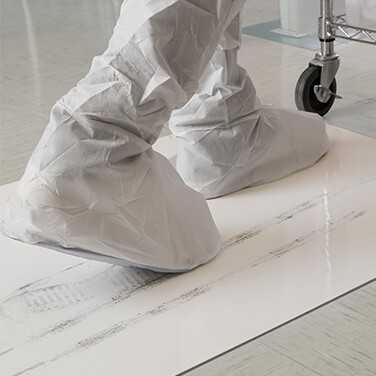PURUS Biohybrid Mats: Sustainable and Environmentally Conscious
Choosing an environmentally preferred product can make an enormous difference with limited effort. PURUS recognizes that sustainable business practices are not only in the company’s best interest, they also benefit associates, suppliers, customers, and the community. That’s why PURUS is committed to helping you achieve your own sustainability goals by providing eco-friendly products.
Environmental concerns may seem difficult to tackle in industrial settings, but they don’t have to be. Consumables, the products required for day-to-day processes, are an easy place to start. Depending on the industry, these products may consume a very large part of the budget, but their environmental impact may not be taken into consideration.
Renewable Resources
Historically, the tacky mats commonly used in cleanrooms and other controlled environments have been made of 100 percent low-density polyethylene (LDPE) from non-renewable resources. Each mat has consisted of 30 or 60 sheets of 1.5mil film coated with 0.3mil thick acrylic-based, pressure-sensitive adhesive.
Now, PURUS™ biohybrid mats, produced exclusively by Purus International, Inc., are the first ever contamination control product to contain renewable plant-based materials. They are an environmentally friendly alternative for socially responsible organizations.
“PURUS will eliminate 135 metric tons of CO2 gas emissions per year with the new process. By comparison, it would take almost 160 acres of forests to sequester that much CO2 in a year’s time.”
Sustainable Choices
To achieve this standard, a special thermoplastic starch (TPS) resin was blended with LDPE to form sheets. The TPS resin, made from renewable, sustainable and GMO-free materials, makes up approximately 20 percent of the biohybrid sheets. The starch sources used also meet specific environmental criteria.
Reducing the Carbon Footprint
Another major benefit of choosing renewable resources is a reduction in the product’s overall carbon footprint. The Centre for Design at RMIT University in Melbourne, Australia, performs Life Cycle Analyses (LCA) to determine the amount of greenhouse gases produced to support human activity. Results of an LCA analysis are usually expressed in equivalent tons of carbon dioxide (CO2).
An LCA performed for PURUS biohybrid mats indicated that by using the hybrid resin, the company’s greenhouse gas emissions were reduced by 11 percent. Further, it estimated PURUS will eliminate 135 metric tons of CO2 gas emissions per year with the new process. By comparison, it would take almost 160 acres of forests to sequester that much CO2 in a year’s time*.
In addition to the described savings, these biohybrid mats further protect the environment with carbon credits used to offset the carbon produced from freight deliveries. By contributing to various forestry, energy-efficiency and renewable-energy projects, PURUS biohybrid mats will offset an additional 140 tons of CO2 per year, an amount equivalent to the effect of another 165 acres of forests.
Performance Benefits
Also, PURUS™ biohybrid mats maintain the same superior performance as their all-LDPE predecessor. In addition to excellent tensile and elongation properties, the mats meet all of the necessary strength, flexibility and durability requirements desired for the product.
The use of renewable materials and contributions to carbon offsets allows PURUS biohybrid mats to sequester 300 tons of CO2 emissions annually without sacrificing performance. While environmental initiatives for production can be difficult to manage, these mats offer an easy solution for companies who want to reduce their overall impact.
*Emissions calculations based on EPA calculations (https://www.epa.gov/energy/greenhouse-gas-equivalencies-calculator)




